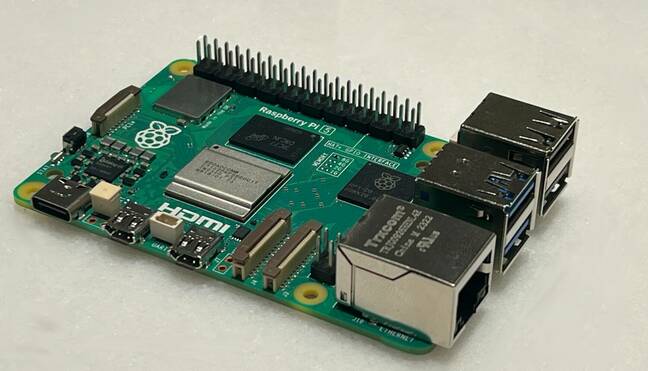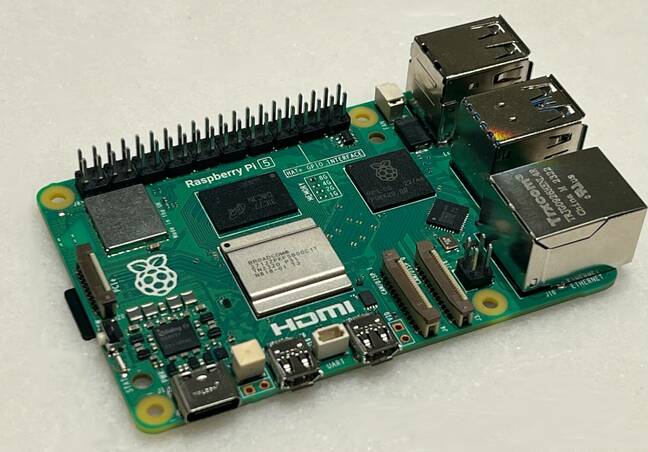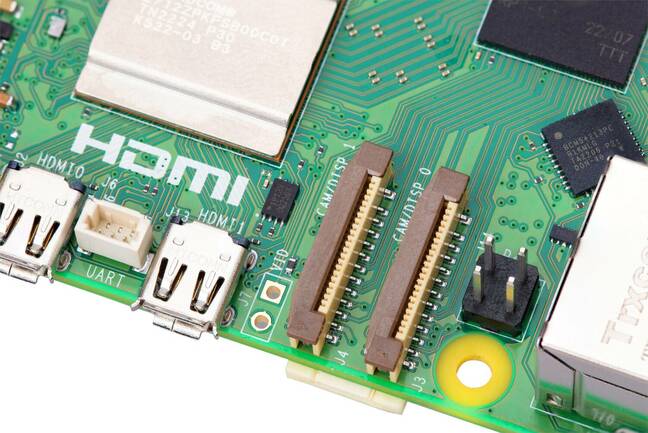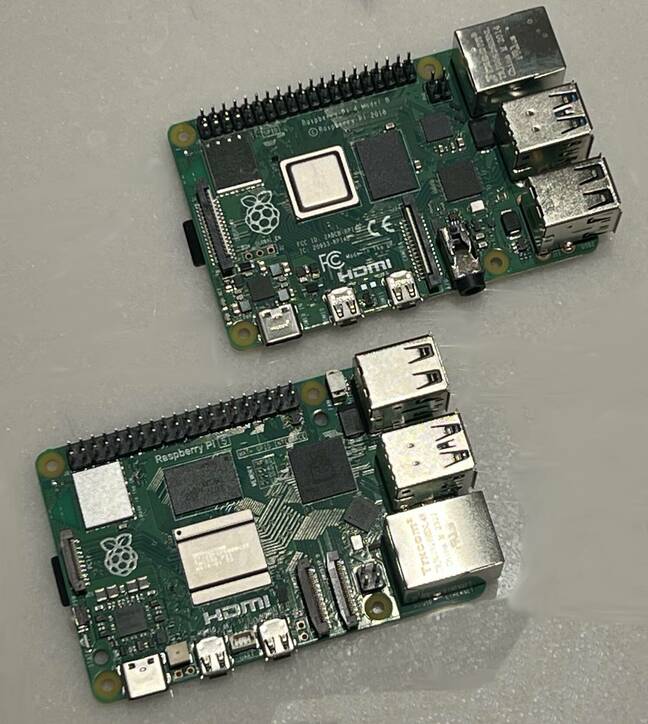Raspberry Pi 5 Revealed, And It Should Satisfy Your Need For Speed
The Raspberry Pi 5 arrives in October with both a leap in performance and an incremental price rise. But will you be able to get your hands on one?
Originally aimed at hobbyists and educators, the Raspberry Pi has evolved into a serious bit of kit over the years despite its diminutive size. The latest generation has continued that evolution into a machine that can chew through most productivity workloads while retaining many of the expansion options beloved by its customers.
However, elements have also been dropped, and the architecture remains more evolutionary than revolutionary.
First, the good news. Performance is impressive when compared to previous generations. According to the Raspberry Pi team, the device, which features a 64-bit quad-core Arm Cortex-A76 processor running at 2.4GHz, represents a 2-3x increase in CPU performance compared to the Raspberry Pi 4.
The graphics are also improved thanks to an 800MHz VideoCore VII GPU. Sure, it won't set racing the hearts of users more used to exotic Nvidia kit, but it does make for a decidedly smoother experience otherwise.
Also swifter is storage thanks to support for the high-speed SDR104 mode, meaning a potential doubling of peak SD card performance – but you'll need to make sure you buy the right SD card to use it. A single-lane PCI Express 2.0 interface is also available, although you'll need an adapter.
Another notable improvement is the inclusion of a real-time clock, but you will have to provide your own battery solution. This is a boon for customers needing to run disconnected for long periods, although third-party options are available for previous generations if needed.
The team said: "For the first time, this is a full-size Raspberry Pi computer using silicon built in-house at Raspberry Pi."
Indeed, there has been somewhat of a step change in performance; even the dedicated two-lane MIPI camera and display interfaces of the past are now replaced by a pair of four-lane 1.5Gbps MIPI transceivers.
However, there is some bad news to stir into the pot. The audio and composite jack has been ditched. According to Pi supremo, Eben Upton, this was due to space constraints on the board. As for what users requiring composite functionality should do, Upton told us: "For composite video, you can see there is a pair of 0.1" pads on the bottom edge."
The news is less good for fans of audio from the deleted jack. He went on: "There's isn't a recommended solution for audio, other than to use either a USB audio device or HAT."
The price has also increased slightly – $60 for the 4GB version and $80 for the 8GB incarnation – and RISC-V is conspicuous by its absence. You'll also need to invest in a new case – the ports have been moved – and the Pi 5 has no cooling tech out of the box.
Upton put the price uplift down to a slight increase in manufacturing cost and a general rise in component prices – other than SDRAM.
The lack of cooling will raise an eyebrow or two, considering how warm the Pi 4 tended to get. The previous generation could be run without a cooling solution, yet sometimes the CPU temperature would soar and hit performance.
Although our review sample came with a separate cooler and fan, the Pi 5 appears to have improved matters temperature-wise. In an admittedly subjective test that involved hammering the hardware with s-tui, stress and firing up a few productivity applications, the CPU temperature climbed to just over 80˚C but went no higher.
Upton said this was due to the updated architecture. He told The Register: "BCM2712 is on 16FFC, so definitely a big improvement in specific energy versus the 28HPC we used for BCM2711. Cortex A76 reputedly has better energy per instruction iso-process, so those two things stack together to give quite a significant improvement for a given workload.
"Which we then more than spend, in terms of peak power, by being able to do a lot more stuff."
Upton also noted that he tended to run the hardware without active cooling.
Availability
Users of the Pi 4 will also remember the aggravation around USB-C power. Lessons appear to have been learned, and Upton told us that the diminutive computer was subject to intensive testing. It will, however, be interesting to see what happens this time when the hardware – which has increased in complexity – hits the wider community. Upton said 100,000 units should be available at launch - scheduled by the end of October - with more to hit the channel in subsequent months.
He said the Pi 4 was "back in a decent stock position," although we've found tracking down all varieties still tricky. He said the pipeline – components and manufacturing – would be good for "roughly" one million units by the end of January.
According to Upton, the balance of the two configurations available has "probably" shifted slightly toward the 8GB variety. The combination presents some intriguing possibilities. The Raspberry Pi OS – now based on Debian "Bookworm" – has been sprayed with updates to handle the hardware changes, although users of the Pi 4 will also see benefits. Some enterprising users have also managed to get other operating systems running on previous generations – most notably Windows on Arm.
While Microsoft has yet to officially support efforts to get Windows 11 working on the device, Upton praised the enthusiasts who had coaxed the software giant's flagship operating system to life on the platform. The additional horsepower available on the Pi 5 could change the experience from being a novelty for hobbyists to something more usable.
- Linux on the Arm-based Thinkpad X13S: It's getting there
- Tinker Tailor Soldier Pi? Asus's 'NUC-sized' SBC aims to out-Pi the Raspberry
- Raspberry Pi production rate rising to a million a month
- Sony Semiconductor sinks Simoleans into Raspberry Pi to advance edge AI
Upton said: "It's been impressive to see people getting Windows up and running. Lots of very ingenious stuff going on there."
As for official support, he said: "That would be a question for Microsoft: we'll certainly support them if they're interested. Historically the issue with 'real' Windows support on Raspberry Pi has been a lack of DirectX drivers."
Implementing DirectX on top of Vulkan would be immensely beneficial, considering the recent investments made by the Pi team.
Some omissions will also vex users, particularly those hopeful of a RISC-V implementation.
Upton told The Register that little consideration had been given to the architecture this time around, noting issues around maturity in the software stack and a lack of "competitive" licensable cores as factors. He said: "A new architecture has to overcome significant barriers to gain acceptance."
However, he also said: "Never say never."
After a week of using the device as a primary computer, we can confirm that the extra performance is most welcome. Yes, we've not been brave enough to run things for any length of time without a cooler, no matter what Upton says – call it Pi 4 PTSD. That said, if you need one, then a cooler is unlikely to break the bank.
As far as stability is concerned, during the time we've had with the review sample we've experienced one occasion where the device froze and required a hard reset. We'll monitor this over the coming weeks and report back if this reoccurs. Otherwise, the Pi 5 put up with the day-to-day abuse of being the primary computer with aplomb.
Getting another case is irritating, although this hack at least has enough Lego in the house to deal with the issue. The price increase might also irk as the Pi 5 is now quite some way from what the first iterations cost. While it can be excused thanks to other improvements, the device is not quite the bargain it once was, which might put off impulse buyers.
Overall, the Pi has evolved into a very useable computer. Upton told us the next generation Compute Module should be along in 2024 but wouldn't comment on other form factors. Updating the Pi-400 hardware would undoubtedly make for some intriguing possibilities and Upton noted that storage speeds in future versions might be further increased through the use of SD Express, "but that standard didn't mature in time for this generation."
And with the European Space Agency having recently updated its Raspberry Pis on the International Space Station – and more hardware due to arrive later this year – could we see a Pi on the Moon before long?
"No comment." ®
From Chip War To Cloud War: The Next Frontier In Global Tech Competition
The global chip war, characterized by intense competition among nations and corporations for supremacy in semiconductor ... Read more
The High Stakes Of Tech Regulation: Security Risks And Market Dynamics
The influence of tech giants in the global economy continues to grow, raising crucial questions about how to balance sec... Read more
The Tyranny Of Instagram Interiors: Why It's Time To Break Free From Algorithm-Driven Aesthetics
Instagram has become a dominant force in shaping interior design trends, offering a seemingly endless stream of inspirat... Read more
The Data Crunch In AI: Strategies For Sustainability
Exploring solutions to the imminent exhaustion of internet data for AI training.As the artificial intelligence (AI) indu... Read more
Google Abandons Four-Year Effort To Remove Cookies From Chrome Browser
After four years of dedicated effort, Google has decided to abandon its plan to remove third-party cookies from its Chro... Read more
LinkedIn Embraces AI And Gamification To Drive User Engagement And Revenue
In an effort to tackle slowing revenue growth and enhance user engagement, LinkedIn is turning to artificial intelligenc... Read more





